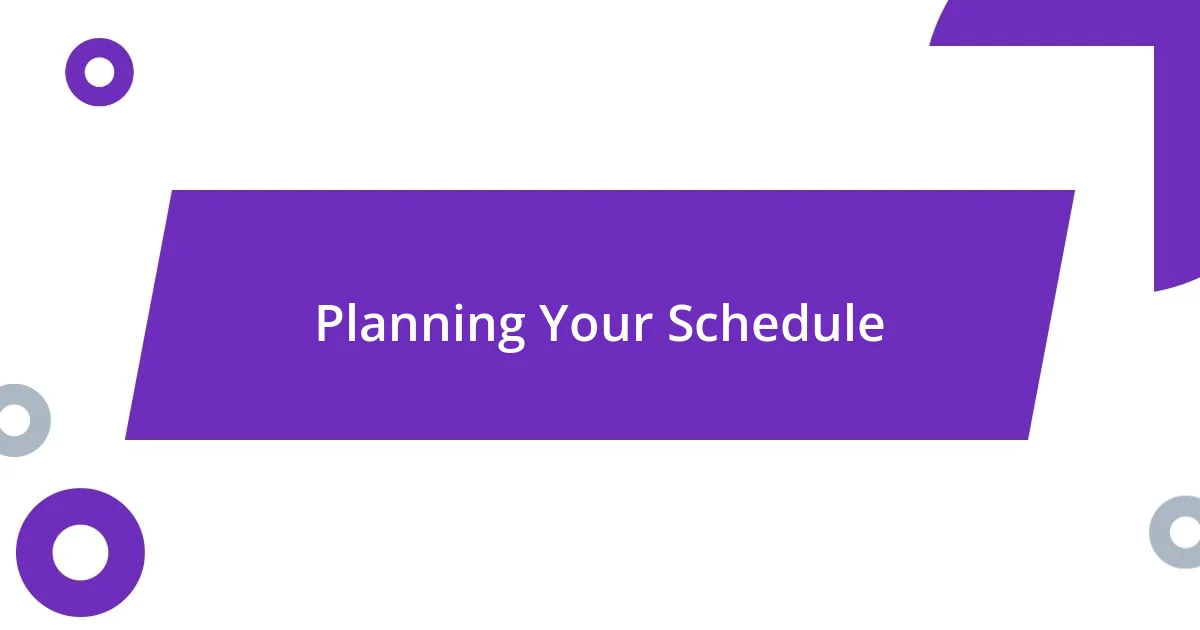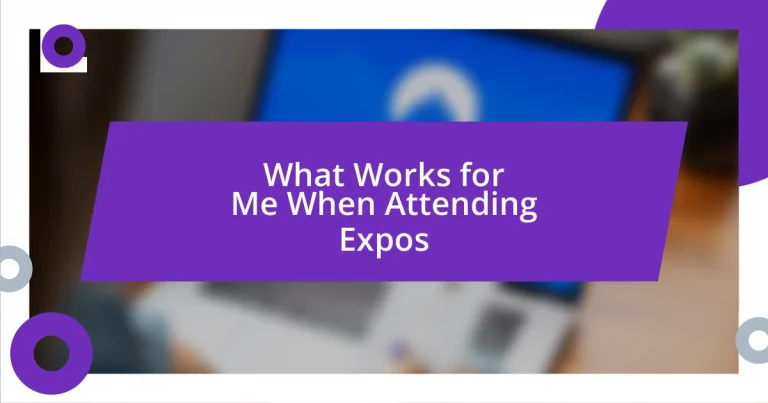Key takeaways:
- Preparing ahead by researching exhibitors and creating checklists enhances the expo experience and ensures valuable connections.
- Setting clear goals helps maintain focus and prioritize interactions during the event, maximizing networking opportunities.
- Following up with personalized messages and evaluating the overall experience post-expo promotes continuous relationship building and strategic improvement for future events.

Preparing for an Expo
Preparing for an expo can feel overwhelming, but I’ve learned to approach it with intentionality. Before you even step foot in the venue, take some time to research the exhibitors. I remember the first time I attended an expo without having a plan; I wandered aimlessly and missed out on incredible opportunities. Isn’t it frustrating to realize you could’ve connected with your dream vendor if only you’d done a bit of homework?
Creating a checklist has become my secret weapon. I jot down not only the booths I want to visit but also the questions I want to ask. Last year, I met a vendor whose product I adored, but I was so flustered that I forgot my most pertinent questions. Reflecting on that moment, I learned the importance of being prepared to make the most of my time and connections.
Packing the right essentials is also crucial. I always bring a portable charger for my phone and a couple of snacks. There’s nothing worse than losing battery mid-conversation or feeling grumpy from hunger. If you’re like me, you might find that being fueled and connected leads to more productive conversations. So, what else do you find essential when preparing for an expo?

Setting Clear Goals
Setting clear goals is crucial. I’ve learned that having well-defined objectives not only helps guide my interactions but also ensures I stay focused. The first time I went without a specific goal, I felt like a leaf in the wind, unsure of where to land. It was frustrating to realize later that I missed some critical connections because I didn’t know what I was truly looking for.
Here are a few tips that work for me when setting those goals:
- Identify key outcomes: Do you want to make specific connections, learn about new trends, or perhaps find partnerships?
- Prioritize your list: Not all exhibitors are created equal—know who’s a must-see and who can wait.
- Set emotional goals: Beyond business objectives, think about how you want to feel during the expo—energetic, confident, or inspired?
- Allocate time wisely: Decide how long you’ll spend at each booth or networking session to avoid getting sidetracked.
By reflecting on my past experiences and pinpointing what I want, I ensure that every expo becomes a stepping stone toward achieving my broader goals.

Planning Your Schedule
When planning your schedule for an expo, the key is to map out your day ahead of time. I remember one expo where I left the schedule blank and ended up overwhelmed by choices. By outlining my priorities beforehand, I could efficiently allocate time to the booths and sessions I genuinely wanted to explore. Have you ever felt lost among too many options? It’s definitely a common pitfall!
I also find it helpful to build in some downtime. After a hectic round of meetings, I need a moment to breathe and reflect. Last year, I started scheduling short breaks between sessions to sip on some water and mentally recap what I learned. This simple practice made all the difference in staying energized and engaged throughout the day, rather than feeling like I was running on empty.
Finally, don’t forget to stay flexible! While I always have a plan, I’ve learned to be open to spontaneous opportunities that come my way. At my last expo, I met a fascinating group of entrepreneurs during my “break time” who shared insights I’d never planned to find. That unexpected encounter turned out to be the highlight of my visit. So, what’s your approach? A little structure combined with spontaneity might just be the recipe for an enriching experience!
| Tip | Description |
|---|---|
| Map Your Day Out | Plan your time strategically to cover key booths and sessions. |
| Include Downtime | Schedule breaks to recharge mentally and physically. |
| Stay Flexible | Be open to unexpected opportunities and connections. |

Networking Strategies at Expos
Networking at expos can sometimes feel overwhelming, but I’ve found that a little planning goes a long way. One strategy I swear by is to approach potential connections with genuine curiosity. During my first expo, I made the mistake of trying to pitch my ideas right away—what a rookie move! Now, I always start conversations by asking solid questions about others’ experiences. This not only builds rapport but often leads to deeper discussions, creating valuable relationships rather than just transactional exchanges.
Another effective tactic I’ve implemented is following up right after the event. It’s easy to gather business cards but I’ve learned that without a touchpoint, those cards often gather dust. I once attended an expo and connected with a mentor who later helped me land a project. I shot her a thank-you email within 24 hours, recalling our conversation, and it opened doors I hadn’t even considered! Timely follow-ups remind people of the connection you made and keeps the momentum alive.
Lastly, I never underestimate the power of body language when networking. At one expo, I noticed that standing tall and maintaining eye contact made me feel more confident—and it reflected in how others responded to me. Have you ever noticed how a simple smile can warm up a conversation? Sometimes, it’s the unspoken gestures that can convey your openness and enthusiasm for connecting with others. Remember, people are often drawn to positive energy, and showing that you’re approachable can lead to surprising opportunities.

Tips for Engaging with Exhibitors
When engaging with exhibitors, I’ve found that clarity is key. Before stepping into their booths, I prepare a few thoughtful questions related to their products or services. For instance, during a recent expo, I asked a vendor why their solution stood out in a crowded market. The conversation not only showcased my interest but also sparked a deeper discussion about the industry trends. Have you ever noticed how a simple question can shape the entire interaction?
Another tip is to actively listen. I remember a time when I was so eager to promote my own ideas that I overlooked valuable insights from the exhibitor. Now, I focus on absorbing their knowledge first. By doing this, I not only learn but also validate their expertise, creating a more meaningful rapport. People appreciate when you value their input—wouldn’t you agree?
Lastly, don’t shy away from sharing your own experiences related to their offerings. At one expo, I found myself discussing a challenge I faced that their product could address. This opened the door for a collaborative brainstorm. Engaging like this transforms a typical vendor-customer interaction into a supportive dialogue. It’s a refreshing approach that often yields unexpected solutions and connections, making the event truly worthwhile.

Following Up After the Expo
Following up after an expo is crucial to solidifying the connections you’ve made. I remember the first time I left an expo without following up; I felt a sense of regret when I later realized I had let some promising connections fade into oblivion. Now, I make it a point to connect with everyone I met on LinkedIn or via email within a couple of days. It’s a simple gesture that shows you value the interaction and want to build on it.
One effective method I’ve found is to personalize each follow-up message. Instead of a generic thank-you, I try to reference specific points from our conversation. For example, after speaking with a startup founder about their innovative eco-friendly packaging, I sent a note mentioning how impressed I was by their vision and how it aligns with my values. This small detail often sparks a further conversation and deepens the connection. Have you ever received a message that felt tailor-made for you? It truly stands out.
I also recommend setting reminders to keep the dialogue going. After an expo, I’ll note down when to check back in with someone, whether it’s to share a relevant article or simply catch up on progress. I had a contact who I followed up with about six months after we met, and our rekindled conversation turned into a collaborative project. These ongoing interactions can lead to unexpected opportunities; don’t you love when a simple follow-up leads to something more substantial?

Evaluating Your Expo Experience
Evaluating your expo experience is more than just reflecting on what you saw and who you met; it’s about analyzing the value of those encounters. I recall an expo where I encountered so many new ideas that it felt overwhelming. At the end of the day, I took a moment to jot down what resonated most and why. This simple practice allowed me to pinpoint which connections and insights truly mattered and helped me prioritize my follow-up tasks.
It’s also essential to think about how each interaction aligned with your initial goals for attending the expo. During one event, I realized that while I was excited about certain products, they didn’t quite fit my business needs. Reflecting on this afterward prompted me to refine my strategy for future expos. Have you ever come away from an event and questioned whether it was worth your time? For me, asking these tough questions turns experience into growth.
Furthermore, I find that keeping a visual or notes repository of materials gathered at the expo helps. After another event, I created a dedicated folder for brochures and business cards, separating those I gained value from and those I didn’t. Later, I revisited them and assessed whether those contacts or information could lead to opportunities. This process taught me to be more selective and strategic about what I pursued post-event. Isn’t it fascinating how a bit of organization can transform the chaos of an expo into actionable insights?














